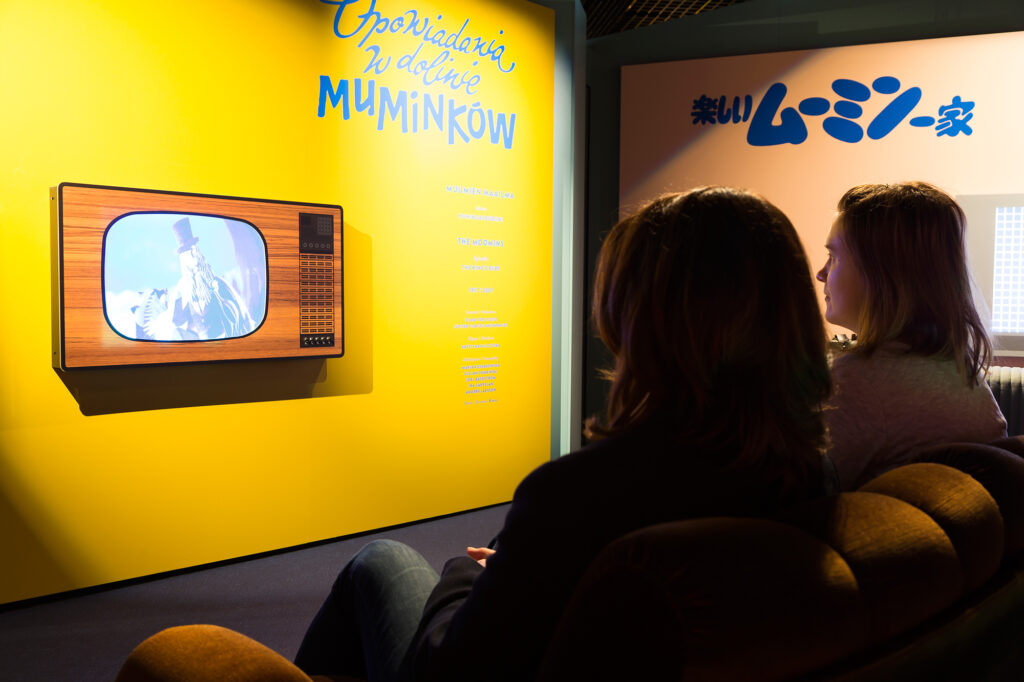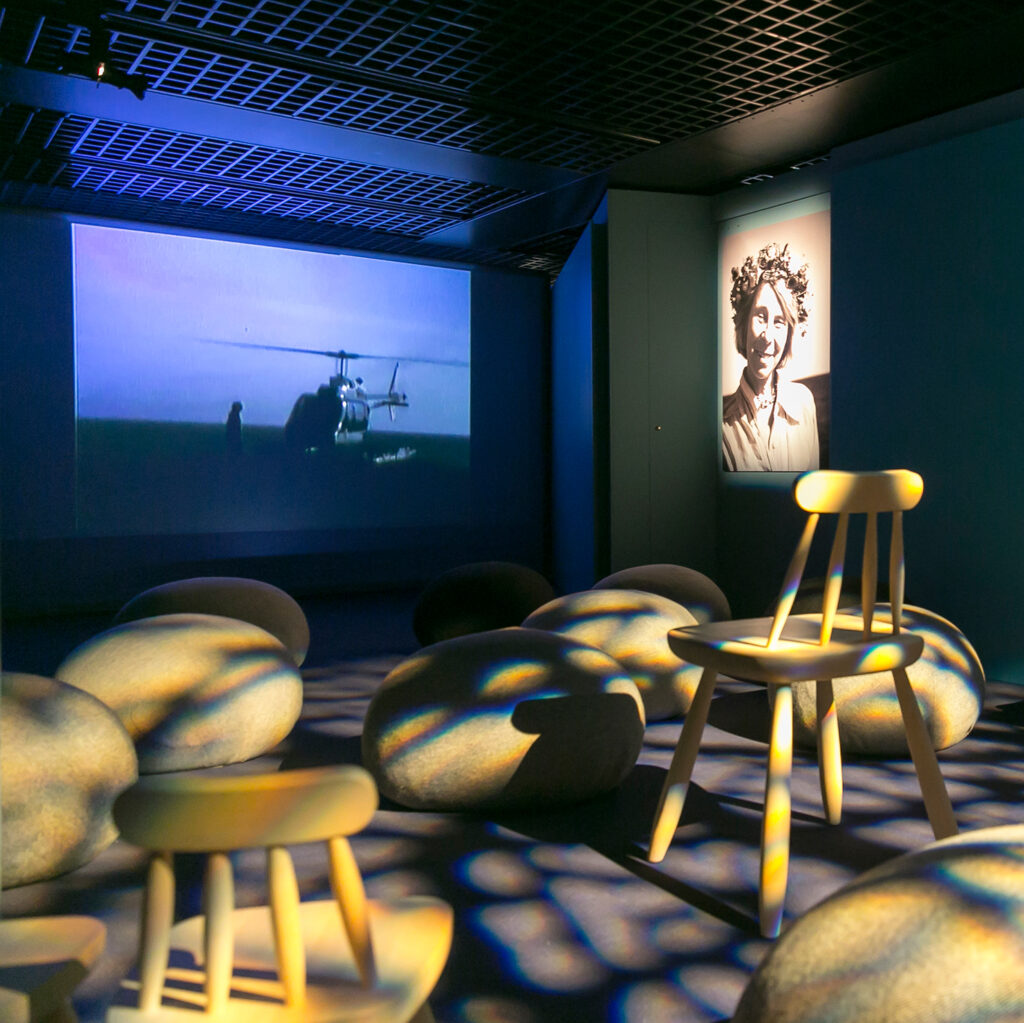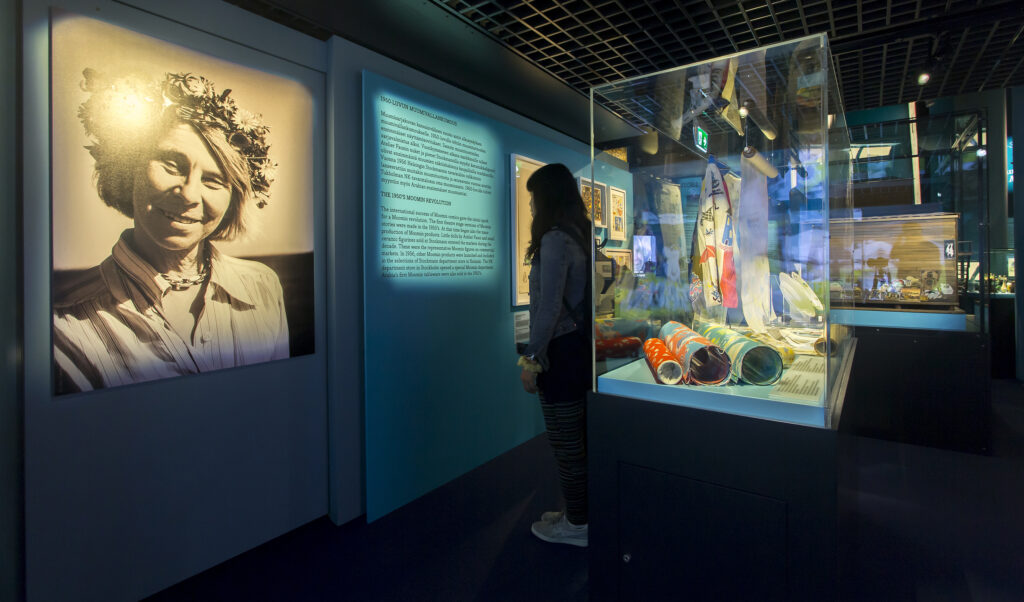Exhibition archive
20.4.2024 – 18.5.2025 An Artist’s Life – Tove Jansson
Tove Jansson (1914–2001) is one of the most acclaimed Finnish artists of the 20th century. Flags are flown across the nation every year on her birthday, August 9th, to celebrate both Jansson and Finnish art. Jansson was a painter, illustrator, cartoonist, writer, comic strip artist and scenographer, but she is best known as the famed creator of the Moomin characters. She published her first drawings and works of fiction at the age of 14, and the last when she was 84.
An Artist’s Life look backs at Jansson’s career and the biographical milestones and relationships that shaped her artistic journey. Jansson was born into a family of artists whose free-spirited values and way of life find reflection in the philosophical outlook of her art. The exhibition examines the formative impact of her childhood growing up in a cultured Swedish-speaking home. It traces the phases of her maturation through her studies, her breakthrough as a painter, her early wartime relationships in bohemian artist circles, and her long-lasting relationship with Tuulikki Pietilä, with whom she spent many summers of love and creative work on the island of Klovharun. It also sheds light on Jansson’s multifaceted career as an illustrator and writer, which has often been overshadowed by her Moomin oeuvre.
The exhibition was produced by the Moomin Museum in collaboration with Moomin Characters Ltd.
29.4.2023 – 31.3.2024 Tumpkin’s time – Poems by Kirsi Kunnas
Merry Tumpkin and his endearing friends are the stars of the Moomin Museum’s new temporary exhibition, Tumpkin’s Time. The exhibition is based on the beloved nursery rhymes authored by the Finnish poet Kirsi Kunnas (1924–2021), who transports the reader to magical worlds of play and imagination. Originally produced by the Päivälehti Newspaper Museum, the exhibition features delightful original illustrations by leading Finnish illustrators. The Moomin Museum now presents the exhibition in the author’s hometown, complete with original illustrations.
The nursery rhymes written by Kirsi Kunnas are a national treasure cherished by ever-new generations of readers. Her poetry is laced with brilliant hilarity and frolicking exuberance that delights and comforts the reader or listener. She debuted in 1956 with Tumpkin’s Fairytale Tree, and her prolific literary output spans many decades all the way to Tumpkin’s Forest published in 2020.
The exhibition features an experiential adventure designed around Kunnas’ nursery-rhymes by artist Alexander Reichstein. The centrepiece is a Fairytale Tree with poems inscribed on its leaves, surrounded by animations and audiovisual material presenting the main characters from the nursery rhymes.
The illustrations are inseparable from the text, speaking the same language and providing a fluent accompaniment to the poetry. Over the decades, the nursery rhymes have been illustrated by many artists. Reimagining the beloved poems in new drawings is always a challenge, but the rollicking world created by Kunnas is always open to new interpretations. The Moomin Museum has augmented the existing exhibition with a selection new original illustrations by contemporary artists including Julia Vuori, illustrator of Tumpkin’s Peppermill and Kristiina Louhi, illustrator of Tumpkin’s Pouch. Their drawings engage in a dialogue with extensive Tumpkin illustrations by Christel Rönns and Pia Westerholm’s cat and dog illustrations, rounded by recent interpretations by Silja-Maria Wihersaari.
21.5.2022 – 26.3.2023 From Tove’s bookshelf
We know the Moomin books, but what did their writer read? This exhibition visits the bookshelves of the artist-writer Tove Jansson (1914–2001) and wonders what a private library says about its owner.
Alongside her illustration collection, Tove Jansson donated hundreds of Moomin books to the Tampere Art Museum, including several different language editions. In 1989, Jansson gifted 410 children’s books, research books on literature and illustration to the Children’s Book Institute. This donation also included adventure books belonging to Jansson’s partner, the artist Tuulikki Pietilä (1917–2009).
Jansson read widely. This exhibition picks illustration art, storytelling from different cultures, and children’s book classics from her bookshelves. Myths from folk stories and strange fairytale creatures are woven into fascinating illustrated worlds. Books were important domestic objects, with personal dedications and various ex libris, or bookplates. Among the bookshelves, you can hear echoes from Moominvalley.
A century of book art can be traced in this collection. Developments in printing techniques offered illustrators new forms of expression, and Tove Jansson was a creative pioneer in the field. She created her books as entire works of art as the writer, illustrator and designer.
The exhibition is a collaboration with the Finnish Children’s Book Institute. Operating in Tampere since 1978, it is the expert organisation and the only specialised library for Finnish children’s and youth literature.
Joy Everyday: Camilla Mickwitz
October 16th 2021 – April 24th 2022
The illustrator Camilla Mickwitz (1937-1989) is familiar to Finns particularly as the creator of the logo for the children’s programme Pikku Kakkonen. Her unique illustration style is simultaneously of its time and timelessly distinctive. The Moomin Museum winter exhibition will introduce Mickwitz’s most beloved characters Emilia, Jason and Mimosa the little witch, alongside the original Pikku Kakkonen logo.
Camilla Mickwitz was an exceptional visual communicator, whose images could carry a story. Her extensive body of work ranged from newspaper illustrations to children’s animations and book illustrations. Mickwitz visualised children’s experiences from their point of view in her lively, vivid imagery. In her books, Mickwitz took on sometimes difficult topical subjects such as immigration, environmental issues and gender equality.
Camilla Mickwitz (née Zilliacus) was born in Helsinki and spent a year as a child refugee in Sweden during World War II. She studied graphic design at the University of Art and Design in Helsinki and worked in advertising before a freelance career. Mickwitz illustrated TV animations, fact and picture books, and publications such as calendars, newspapers and magazines. She was accomplished in diverse media, creating her animations and books with a variety of techniques, from watercolours to photography.
The artworks in this exhibition are on loan from The Finnish Institute for Children’s Literature, a national expert organisation that has operated in Tampere since 1978. The institute maintains the only specialist library of children’s and youth literature in the country. The collection contains about 4000 original illustrations by Finnish children’s book illustrators.
© Camilla Mickwitz

Lotta, Mardie and the Lionhearts – Ilon Wikland’s storybook illustrations
11.5.–19.9.2021
The Moomin Museum spring 2021 temporary exhibition invites visitors to the timeless world of Ilon Wikland. Wikland has enjoyed a long career as a children’s storybook illustrator and is particularly known for illustrating Astrid Lindgren books. The Moomin Museum exhibition takes us on an adventure with Mardie, the children of the Noisy Village, little Lotta, Karlsson on the Roof, Brothers Lionheart and other characters from Lindgren books. Wikland’s pen imagined the lush green gardens, colourful wooden houses and lively children in their happy play. The artworks in the exhibition are on loan from Ilon’s Wonderland museum in Haapsalu, Estonia, and is the largest ever seen outside Estonia.
Ilon Wikland (née Pääbo) was born in Tartu, Estonia in 1930. Wikland spent her childhood in Tallinn and Haapsalu, until she was sent to safety Stockholm in 1944 during World War II. After studying art, young Wikland landed a job as an illustrator at the Rabén & Sjögren publishing house. There she met the writer and editor Astrid Lindgren (1907-2002), leading to a collaboration spanning decades. Lindgren was already an established children’s writer, and the first illustration Wikland created for a Lindgren book was Mio, My Son (1954). During their long collaboration, Wikland’s illustrations brought to life many of the best known Lindgren characters. Wikland’s charming world, with its echoes of the green Estonian countryside, has fascinated children for decades.
Ilon’s Wonderland – the museum dedicated to Ilon Wikland´s illustrations – was founded in 2006. Ilon Wikland decided to donate 800 of her original book illustrations to Estonia as a gift. The suitable location for displaying the works was found in Haapsalu, very close to the home of Ilon’s grandparents. Aside from admiring her work, one can also draw, play, do crafts, watch movies, enjoy plays and concerts, participate in educational programmes, hold birthday parties and spend a wonderful day with family in Ilon´s Wonderland.
© Design Ilon Wikland AB
Moomins and the Sea 15.2.2020–31.12021
The Moomins love nothing better than a maritime adventure, and their creator, Tove Jansson (1914–2001), drew a lifetime of inspiration from the Baltic Sea. Echoes of her sea can be heard on the beaches of Moominvalley and in the stormy exploits of the Moomin characters. Maritime themes are woven through many Moomin tales, and the sea defines the contours of Moominvalley just as the Baltic Sea paints the outlines of Finland.
This exhibition takes a look at the Moomins’ nature-loving lifestyle through a selection of Jansson’s original illustrations, featuring images of the Moomin characters embarking on adventurous sea voyages and enjoying picnics on rocky shores. In Jansson’s stories and illustrations, the wide-open sea glistens on the distant horizon as an ever-present companion, almost like one of the living characters in the books.
The Moomins always treat nature with respect. They eat, live, and travel in harmony with the environment. Their simple lifestyle is kind to the earth and the sea. Like the Moomins, we can all consider nature in our daily choices, and everyone can do their bit to help protect the Baltic Sea. After all, the sea is made up of many small droplets.
2020 marks the 75th anniversary of the publication of the first Moomin book. To celebrate this special anniversary, the Moomin Museum is participating in the #OURSEA campaign, launched by Moomin Characters. The aim of the campaign is to increase awareness of the condition of the Baltic Sea and raise one million euros for John Nurminen Foundation’s work to protect the Baltic Sea and its heritage. The Baltic Sea is a unique ecosystem, and it’s the only sea we have, so let’s take good care of it!
Moomin Animations – Thrills and Cuddles 25.4.2019 – 26.1.2020
Many different animated versions of Tove Jansson’s (1914–2001) beloved Moomin books have been produced over the decades; many readers will be surprised to hear that the earliest versions date back almost 60 years. Who among us doesn’t cherish fond memories of growing up with Moomin tales on TV?
Most of us can distinctly remember the mounting sense of suspense as the Moomin adventures unfolded upon the screen – yet the thrills never grew too scary. There was always the cosy warmth of the Moomin world to make us feel safe and snug again. Sharing the experience with family and friends doubled this dual sense of adventure and cosiness. The Moomin animations bring back cherished childhood memories for many of us, while for many parents, they bring back fun moments spent watching TV together with the kids – or a moment’s respite from the daily grind as the kids sat with their noses pressed against the screen. Some of us also fondly remember endless Moomin marathons shared with friends.
The very first Moomin film to premiere on TV was a German black-and white marionette animation filmed in 1959. The first Japanese animations came ten years later, and the first Russian version following in the 1970s. At the end of the 1970s a Polish puppet / cut-out animation aired in a number of countries. To date the most famous Moomin animation ever made was the Japanese Delightful Moomin Family series, which had its TV debut in 1990. The series aired in over 120 countries, followed by repeated reruns. A brand-new Finnish-made animated series by Gutsy Animations – Moominvalley – had its international premiere in spring 2019.
Whether your happy memories of Moomin animations are based on the famous Japanese series or the very earliest versions, you can now sit down and relive the experience at the Moomin Museum. There will be TVs showing different versions of Moomin animations in various techniques from different periods. The exhibition will also look at the history of animation, including a peek at the latest production by Gutsy Animations. The exhibits include archival material such as different manuscript versions, hand-drawn sketches, ready animation drawings, three-dimensional models, sound samples and digital mock-ups.
A feature common to all the animations of the past 60 years is that each one offers its own unique take on Tove Jansson’s Moomin books and comic strips. Past animations also feature many of Jansson’s iconic original images, such as Moomintroll and Snufkin on the bridge and the Moominhouse sitting cosily in its spot in the valley. Alongside the animations, the Moomin Museum will present original illustrations from its collections – the “master versions” to which all the later animations owe their existence.
Fairytale Cabin – Illustrations of Usko Laukkanen 15.12.2018 – 31.3.2019
Fairytale Cabin is the Moomin Museum’s exhibition featuring the unsung achievements of the Finnish illustrator Usko Laukkanen (1930-2000), who carved out a long, rich career during an era when illustrators received little recognition. Their work was in fact often published uncredited. Though Laukkanen’s work is loved by many, his name is lesser known among wider audiences.
Laukkanen was a highly versatile illustrator and comic artist. He is known primarily as an illustrator of children’s picture books and textbooks. A whole generation grew up with his illustrations for the Finnish Children’s ABC and First Reader (1958) and its later editions, as well as the textbooks he illustrated for the Otava and Valistus publishing companies.
Among his crowning achievements was his self-authored book Laulumaja (Song Cabin, 1956), which placed third in a Nordic picture book competition and was the only Finnish book ever released in the Tammi publishing company’s Little Golden Books series. Translated editions were published in a number of countries.
Picture books and fairytales were important to Laukkanen, an industrious illustrator who spared no effort adding lively touches and perfecting every detail of his illustrations. The works in the exhibition are all original drawings, in which the colours glow brighter than ever seen in print.
Later Laukkanen worked as a commercial artist (for clients including the Finnish Road Safety Council and Postipankki Bank) and animator (notably as the creator of Esso’s ‘tiger in the tank’ commercial from the 1960s). Towards the end of his career he chiefly worked for Satukustannus. He illustrated dozens of picture books for this Tampere-based publishing house from the 1970s to the 1990s, some of which were translated into Swedish and Russian.
Laukkanen additionally made a mark as a comics artist. His best-known series Masto ja Märssy (Mast and Crow’s Nest) was published in the Finnish comics periodical Sarjis in the early 1970s. He spent decades working on his unpublished Captain Kidd strip. Laukkanen received the Puupäähattu Award for Finnish Comics Artists in 1988 in recognition of his small yet distinctive body of work in comics art.
Fairytale Cabin was produced in collaboration with the Finnish Comics Museum.
Cinema Observatory 26.6.-31.8.2018
Three short films about Tove Jansson and the Moomins.
Tove Jansson and the Moomins 9.8.2017-26.5.2018
The Moomin Museum’s first temporary exhibition, Tove Jansson and the Moomins, presents the evolution of Jansson’s Moomin figures, including her black 1930s Moomins, her satirical 1940s cartoons for the political periodical Garm, the first 1950s Moomin souvenirs, and the 1990s Moomin animations. Highlights include an animated version of the very first Moomin drawn by Jansson when she was a teenager. Other special attractions include her early Moomin comic strips published in the Swedish periodical Ny Tid in the 1940s, Faun puppets from the 1950s, the very first Moomin mug produced by the Arabia porcelain company, and numerous original cover illustrations custom-designed for specific language editions.






